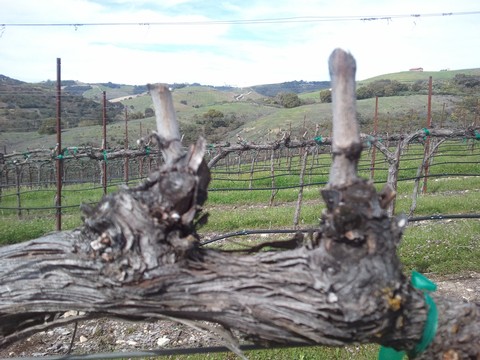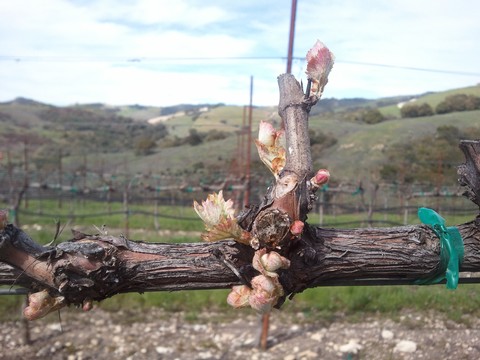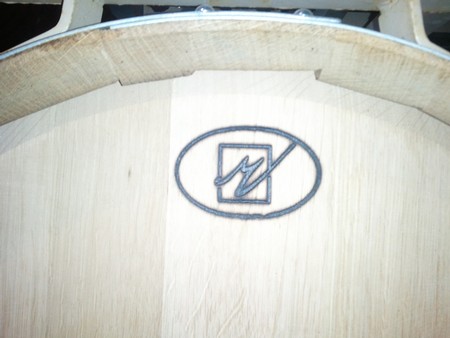In the fall, the leaves on the vines turn their beautiful colors and eventually fall off. The vines themselves enter a dormant state, mirroring the farmers and vintners who need a long winter's nap to recover from harvest.
Eventually spring rears its wonderful head bringing warmth and sunshine to wake everything up again. The buds on the pruned vines begin to break open and the great cycle of the vintage begins. This week at the end of March marks that beginning for the 2011 vintage.
Now either in tasting notes you have read, or at some winemaker's speech you have survived, you may have heard that not all grapes ripen at the same time. Here at Calcareous, some grapes we pick at the end of August and some we pick in the middle of November. And contrary to what some might say, that waiting until November is not some ploy to get the fruit "over ripe" to make big jammy Paso wine. No, the fact is, each variety planted here marches to its own beat when determining the timing of when its fruit will be ready. Some vines take their own sweet time, and no other time of year shows this as clearly as bud break.
Every year, the first grape picked off the Calcareous vineyard is the Chardonnay. Here is what that Chardy looks like today.

Hope and life spring eternal, literally! An exclamation because you don't get to be literal all that much in life these days. Now of course, the constant worry of a freeze that could damage these fragile buds is ever present. Well, not actually. Here is a tip to any of you out there that are looking to plant a vineyard for your future award winning estate winery. Plant on a steep hill. Oh sure, it makes working the vineyard feel like a constant mountain hike, you need crawler tractors, and irrigation and ripening are irregular. But the big plus, we have never had a frost problem here*. So these buds will soon be leaves, stems, and flowers.
Now, why don't we walk 75 yards due east and see what is happening with the Mourvedre.

Um, not much. Mourvedre is always in a race with the Lloyd Block Cab Sauv to see who gets picked last. And as you can see here, budding is still a couple weeks away. Not a hint of green anywhere in the whole block. The Mourvedre vines are weeks behind the Chardonnay in general life cycle. Thus, the fruit will ripen weeks later. Sure this is a bit of a simplification of things, but it is always interesting to me see the order of bud break as it outlines my general planning of harvest.
You can start to put together a flow chart in your mind of what fruit will go into what fermenters. There are dreams about various co-ferments from fruit that ripens at the same time. Last year, the top of a section of Syrah and the bottom of the Merlot broke the same week. So I thought, why not, during harvest a small 1 ton co-ferment of the two. If you ever visit in the next year, you can taste that experiment and see what you think. I for one am in love as these two maligned beauties work wonders together. Things like that won't happen every year, so by paying attention to the vineyard now, you can prepare for the little bits of magic as they may occur.
Finally, an aside for those who read my post on pruning. I mentioned that the ideal goal is to get two buds from each spur position. This way you get the low yields and concentrated fruit you hope for. I also mentioned that this two bud thing is a dream. Sometimes, like in the above Chardonnay photo, you get a perfect two buds and all is well. Sadly, a lot of the time things look like this Malbec here.

A solid 8 buds there, and that is only the one side. This means that we will have to go back through in the next month, and pull off all the extra shoots. So for those keeping count, this will be the second time this year each vine will be visited and adjusted by hand. There will be many more of these visits over the next 6-7 months. Hopefully I'll write a little post about each of them.
*Please Snow Miser, I am not challenging you. Please stay down in your cold, yet comfortable low lying areas.
What a just plain fantastic time of year this is. Things are starting to warm up and the vines will be budding any moment now. And with that warm air comes some of my favorite American activities. Baseball and BBQ are starting to get going. And nothing goes better with those activities than Zinfandel. Well, I won’t get carried away here. A solid pint of beer goes down with those two perfectly as well. I’ve been enjoying some Pliny The Elder along with my usual Anchor Steam and local favorite Firestone Double Barrel. But the Paso Robles Zin fest is here this weekend and Paso Robles Adult Co-Ed softball season kicks off, so I’m sticking with Zin, Tri-Tip, and Bat and Glove for today.
Don’t know if you missed this, but Paso has a new attitude about its Zinfandel bona fides. Here is the ad the area pitched in to produce hyping up our Zinfandel production. Note the baseball reference in there as well.
When people talk of “food friendly” wine, it seems they are rarely talking about Central Coast BBQ. It may not be proper French cuisine, but it is food. And damn good food at that. And it pairs with big Paso Zins like nothing else. It reminds me of my basic pairing rule, pair flavors from the same region. Here in Paso, we like to cook big slabs of meat on top of oak fires with plentiful sauce. This produces a meal filled with richness, smoke, and decadence. If you want your wine to match up, put the German Riesling away and grab some Paso Zin. Our 2007 Zin will go on sale for the last time this weekend; it is the official drink of my backyard right now.
And for a final thought, I just want to hype up my trusty softball glove that I oiled up last night. Getting out the old leather after a few months just brings back all those great memories of getting excited for little league and pick up games as a kid. There really is nothing quite like the smell and feel of oiling a perfectly broken in mitt as an American ceremony for saying good riddance to winter. Perusing the local sporting good store recently though, I was a bit saddened at the condition of the baseball/softball mitt world. For one, nothing I could find in this area was made in America. And worse, all the leather felt thin and stiff, none of the life you want from a good glove. So if you play, or are in the market for something for a kid just starting out, do yourself a favor and check out Nokona. Nokona is the last company that hand makes gloves in America for America’s pastime. They are simply an amazing product that is in a class all by itself. They even have gloves made of bison if you want to get truly USA all the way. Like the wine I make, and the barrels I use, they strive to be hand made works of art.

There really is no way of describing the difference in feel between one of these gloves and the usual store bought one you find at Wal-Mart or wherever. It just feels right, heavier duty in everyway, but much more supple at the same time. You will want to just go play catch the second you put it on. So get out there, winter is receding and spring is in the air. Goodtimes!
Oh and how could I forget....
One of the things that connects me most to winemaking at a small family owned winery like Calcareous is the handmade nature of the product. All work done on the vines is done by hand. The fruit is hand picked. And in the winery during crush, the wine making here is defintely hands on. Which all comes to mind this time of year when meeting with the salespeople and coopers from the cooperages that make the barrels we use. Although for simplicity reasons we often categorize the oak used in wine making as French, American or European, reality is much more interesting than that. After all, do we just lump in all grapes as being either French, Spanish or Italian?
Making barrels is just as much an ancient artisian craft as wine making. Each barrel is hand made and toasted by some one with oak staves, steel hoops, a hammer, and a fire pit in the ground. The way the flavors of the barrel integrate with the wine and the life the wine lives while aging are much more influenced by the person who made that barrel than by just where the tree was grown. In recent years, the barrels of Tonnellerie Meyrieux have become one of my favorites and used in both my Rhone and Bordeaux programs. There might even be an expansion into the world of Pinot Noir.
If you are ever on a cellar tour and see this logo, you can impress the tour leader and fellow "tourists" (is that the proper word?) with the question "So how do you feel the powerful Meyrieux (pronounced May-Roo) barrels impact the wines made here?"

Powerful is the key word here. From 2007-2009 these barrels were only allowed to interact with Syrah, the power king of West Side Paso Robles. The method used for toasting these barrels produced wonderful flavors that softness to powerful wines like no other barrel I have ever used. As you can see here, the "House Toast", basically the toast the cooper feels is the best expression of their barrel, is made with Syrah in mind.

A house with the word Syrah is a foolproof way to tell the sleep deprived english speaking wine maker what to do with this barrel. Last year, after talking with the cooper and requesting a special lower temperature, longer timed toasting regiment, these barrels moved into Cabernet, Merlot and Petit Verdot. And after tasting through the barrels with him this past week, we were both very pleased with the outcome. This year he even had a new brazier designed that will allow an even milder yet deeper toast to the barrel.
This has led me to expectation of expanding the Meryrieux usage out to other varietals. Cab Franc, Pinot Noir (Meyrieux is located in Villers-La-Faye France after all), maybe even get crazy and put some Marsanne in one. We'll see. But one can not underestimate the importance of tailoring your barrel program to your wine making. And remember to thank the word's hard working artisan barrel makers the next time you taste perfect aging and oak integration in your glass.